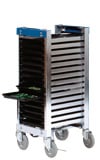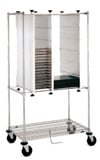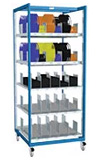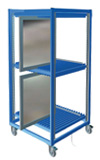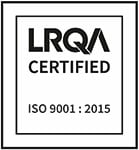- Category
Skip to Content
Language
Language: English
- Categories
- Anti-Fatigue & Floor Mats
- Carts, Cabinets & Storage
Carts, Cabinets & Storage
- Bins, Totes & Trays
Bins, Totes & Trays
- Attached Lid Containers
- Bins
- Bin Dividers
- Bin Cabinets
- Bin Carts
- Bin Panels
- Bin Shelves
- Divider Boxes
- ESD Bins, Totes & Trays
- Straight Wall Containers
- Totes
- Trays
Popular Brands
- Cabinets
- Carts & Cart Covers
Carts & Cart Covers
- Utility Carts
- Dolly Trucks
- Cart Covers
- Powered Workstation Carts
- Lab & Healthcare Carts
- Security Carts
- Semiconductor Carts
- SMT Carts
Popular Brands
- Ladders
- Lockers & Secure Storage
- Mezzanines
- PCB Handling
PCB Carts & Handling
Popular Brands
- Pipe & Joint Systems
- Steel Shelving
- Trucks
- Waste Management
- Wire Shelving
Catalogs
- Bins, Totes & Trays
- Chairs & Seating
- Chemicals & Cleaners
Chemicals & Cleaners
- Bases
- Disinfectants & Sterilants
- General Purpose Cleaners
- pH Buffers
- SMT Chemicals
- Solvents
Solvents
Popular Brands
- Test Strips
- Ultrasonic Cleaners
Ultrasonic Cleaners
Popular Brands
- Cleanrooms & Equipment
Cleanrooms & Equipment
- Cleanroom Construction
Cleanroom Construction
Featured Partners
- Cleanroom Components
- Cleanroom Furniture
- Gowning Room Furniture
- Ionization Equipment
- Monitoring & Testing
Monitoring & Testing
Popular Brands
- Cleanroom Construction
- Cleanroom Apparel & Supplies
Cleanroom Apparel & Supplies
- Apparel
- Bags, Packaging & Tape
- Cleanroom Paper
- Cleanroom Pens
- Custodial Products
Custodial Products
- Brushes
- Cleaners & Solvents
- Disinfectants
- Mops
- Spill Control
- Squeegees
- Tacky Rollers
- Vacuums
- Waste Receptacles
- Wipes
Popular Brands
- Gloves & Safety Wear
- Hand Soap & Sanitizer
- Razor Blades
- Sterilization Wrap
- Sticky Mats
- Wipes, Swabs & Cleaners
- Custodial Products
-
Dispensing & Adhesives
Fluid Dispensing
- 2-Component Dispensing
- Dispensers
- Dispensing Bottles
- Dispensing Materials
- Dispensing Robots
- Dispensing Tips
- Syringes & Components
- Valves & Controllers
Popular Brands
- Dry Cabinets & Storage
Dry Cabinets & Storage
- 3D Printing Dry Cabinets
- Desiccator Cabinets
- Drawer & Tray Desiccators
- Pass-Thru Desiccators
- Specialty Dry Cabinets
- Tape & Reel Cabinets
- Wafer Storage Desiccators
Popular Brands
-
Facilities & Warehousing
Facilities & Warehousing
- Air Purifiers
- Battery-Powered Workstation Carts
- Cable Management
- Carts & Cart Covers
- Custodial Products
Custodial Products
- Brooms & Brushes
- Cleaners & Disinfectants
- Hand Dryers
- Hand Soap & Sanitizer
- Hand Soap Dispensers
- Hand Washing Sinks
- Mops
- Signs & Barriers
- Spill Control
- Squeegees
- Vacuums
- Waste Management
Popular Brands
- Floor Tape & Safety Signage
- Ladders
- Lockers & Secure Storage
- Mats & Flooring
- Mezzanines
- Office Supplies
-
Packaging & Shipping
Packaging & Shipping
- Partitions & Enclosures
- STAK System®
- Storage & Material Handling
- Strip Doors
- Work Platforms
Catalogs
- Garments
Garments by Type
- Disposable Garments
Disposable Garments
- ESD Garments
- Reusable Garments
- Sterile Garments
Sterile Garments
Garments by Category
- Disposable Garments
- Gloves & Safety Wear
Gloves & Safety Wear
- Labs & Healthcare
Labs & Healthcare
- Lab & Healthcare Furniture
Lab & Healthcare Furniture
- Lab Environments
Lab Environments
- Lab Equipment
- Lab Coats & Garments
- Lab Supplies
- Lab & Healthcare Furniture
-
Microscopes & Magnifiers
Microscopes & Magnifiers
- Benchtop Magnifiers
- Binocular Microscopes
- Eyepiece-less Microscopes
- Handheld Inspection
- Microscope Accessories
Microscope Accessories
- Trinocular Microscopes
- Video Inspection Systems
Popular Brands
-
Packaging & Tapes
Packaging & Tapes
- Bag Sealers
- Cleanroom Packaging
- ESD Packaging
- Non-Adhesive Cutters
- Packing Stations
Packing Stations
-
Printers & Labelers
- Tapes
- Solder & Rework
Solder & Rework
- Desolder & Rework
- Replacement Parts
- SMT Chemicals
- Soldering Irons & Stations
Soldering Irons & Stations
- Solder, Flux, & Consumables
Solder, Flux, & Consumables
Popular Brands
-
Soldering Accessories
Soldering Accessories
- Stencil Rolls
- Tips, Nozzles & Tip Care
Tips, Nozzles & Tip Care
- Vacuum Pick-up Tools
Popular Brands
- Stainless Steel Tables
- Static Control
Static Control
- Anti-Static Mats & Hardware
Anti-Static Mats & Hardware
Popular Brands
- Bins & Totes
- Custodial Products
Custodial Products
- Flooring & Mats
- Gloves
- Ionization Equipment
- Meters & Testers
- Packaging
- Personal Grounding
- ESD Garments
- SMT Carts & PCB Handling
SMT Carts & PCB Handling
Popular Brands
- Staticide
- Workstations & Seating
- Workstation Accessories
Workstation Accessories
- Badge Holders
- Binders & Clipboards
- Brushes
- Dispensing Bottles
- ESD Drinking Cups
- ESD Organizers
- Microelectronics Wipes
- Rubber Bands
- Sheet Protectors
- Tape Dispensers
Popular Brands
Ionization Equipment
Popular Brands
- Anti-Static Mats & Hardware
- Test Equipment
Test Equipment
- Cleanroom Meters & Testers
Cleanroom Meters & Testers
Popular Brands
- Carbon Dioxide Monitors
- Clamp Meters
- Electrical Testers
- ESD Meters & Testers
- Light Meters
- Manometers
- MultiMeters
- Sound Meters
- Thermal Imaging Cameras
- Thermometers
- Thermohygrometers
- Cleanroom Meters & Testers
-
Thermal Interface Materials
Thermal Interface Materials
- Gap Pads
- Insulators
- Liquid Gap Fillers
- Phase Change Materials
- Specialty Thermal Interface Materials
- Tapes & Adhesives
- Thermal Grease
Popular Brands
- Tools
Tools
- Brushes
- Hand Tools
- Heat Guns
- Knives & Blades
Knives & Blades
Popular Brands
- Micrometers, Calipers & Rulers
- Power Tools
Power Tools
Popular Brands
- Scissors
- Surgical Instruments
Surgical Instruments
Popular Brands
- Torque Tools
- Wipes & Swabs
Wipes & Swabs
- Cleanroom Wipes
- Low-Linting Task Wipes
- Lab & Healthcare Wipes
- Microelectronics Wipes
- Stencil Cleaning Wipes
- Stencil Rolls
- Swabs
Popular Brands
- Wire Shelving
Wire Shelving
- Wire Shelving Units
- Wire Shelving Add-Ons
- Mobile Wire Shelving
- Shelves
- Posts
- Casters
- Accessories
- High-Density Track Storage
- MetroMax iQ Polymer Shelving
Popular Brands
- Workbenches & Workstations
Workbenches & Workstations
- Workbenches
- Modular Workstations
- Powered Workstation Carts
- Packing Benches
- Flow Racks
- Accessories
Workbench Accessories
- Backstops & Edge Stops
- Bin Rails
- Cabinets
- Casters
- Column Trim
- Computer Accessories
- Drawers
- Leg Extenders
- Lighting
- Foot Rails
- Footrests
- Grounding Jacks
- Monitor Arms
- Pegboards & Panels
- Power/Data Strips
- Roll Holders
- Shelves
- Shelf Dividers
- Tool Balancers
- Uprights
- Wire Holders & Cable Trays
- Workstation Dividers
Specialty Workstations
Popular Brands
- Services
- All Brands
- Promos
- Technical Articles
- About P|A|C
Search
LanguageLanguage: English
- Home
- Products
- Storage & Material Handling
- Carts & Cart Covers
- Electronics & PCB Carts
Search

